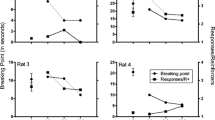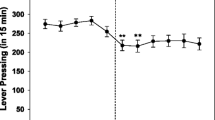Abstract
The opioid system plays an important role in feeding. In general, opioid agonists typically increase feeding and opioid antagonists decrease feeding in nonfood restricted animals. In food restricted animals the effects of these drugs are substantially reduced. Opioid antagonists have shown a marked effectiveness at reducing consumption of sweet foods. Explanations for this robust effect have typically focused on drug induced changes in taste, taste perception, or palatability. The current study relates the effects of the opioid antagonist naloxone on motivation to obtain different sucrose concentrations to the drug's effects on unrestricted sucrose solution consumption. Changes in motivation to respond were assessed under a progressive ratio reinforcement schedule (PR) which required increased response cost for each successive unit of sucrose solution. Motivation, as measured by the PR, increased as sucrose concentration increased and naloxone produced a dose-dependent decrease in motivation to respond for a given sucrose concentration. Thus, the effectiveness of naloxone was indirectly related to strength of the sucrose concentration. Under unrestricted access to sucrose solutions, naloxone reduced consumption greatest under the higher concentrations. The data suggest at least part of naloxone's effects on sweet tasting food may be mediated through endogenous opioid reward systems that are reflected in measures of motivation.
Similar content being viewed by others
References
Apfelbaum M, Mandenoff A (1981) Naltrexone suppresses hyperphagia induced in the rat by a highly palatable diet. Pharmacol Biochem Behav 15:89–91
Beczkowska IW, Bowen WD, Bodnar RJ (1992) Central opioid receptor subtype antagonists differentially alter sucrose and deprivation-induced water intake in rats. Brain Res 589:291–301
Beczkowska IW, Koch JE, Bostock ME, Leibowitz SF, Bodnar RJ (1993) Central opioid receptor subtype antagonists differentially reduce intake of saccharin and maltose dextrin solutions in rats. Brain Res 618:261–270
Bertino M, Beauchamp GK, Engelman K (1991) Naltrexone, an opioid blocker, alters taste perception and nutrient intake in humans. Am J Physiol 261:R59-R63
Cleary J, Nader M, Thompson T (1986) Effects of imipramine on responding reduced by methadone. Pharmacol Biochem Behav 25:149–153
Cooper SJ (1983) Effects of opiate agonists and antagonists on fluid intake and saccharin choice in the rat. Neuropharmacology 22:323–328
Cooper SJ, Jackson A, Kirkham TC, Turkish S (1988) Endorphins, opiates and food intake. In: Rodgers RJ, Cooper SJ (eds) Endorphins, opiates and behavioural processes. John Wiley, London, pp 143–186
Czirr SA, Reid LD (1986) Demonstrating morphine's potentiating effects on sucrose-intake. Brain Res Bull 17:639–42
Drewnowski A, Krahn DD, Demitrack A, Nairn K, Gosnell BA (1992) Taste responses and preferences for sweet high-fat foods: evidence for opioid involvement. Physiol Behav 51:371–379
Egli M, Schaal D, Thompson T, Cleary J (1992) Opioid-induced response rate decrements in variable interval schedules: reinforcement mechanisms. Behav Pharmacol 3:581–591
Fantino M, Hosotte J, Apfelbaum M (1986) An opioid antagonist, naltrexone, reduces preference for sucrose in humans. Am J Physiol 251:R91-R96
Gosnell BA, Majchrzak MJ (1989) Centrally administered opioid peptides stimulate saccharin intake in nondeprived rats. Pharmacol Biochem Behav 33:805–810
Gosnell BA, Majchrzak MJ (1990) Effects of a selective mu opioid receptor agonist and naloxone on the intake of sodium chloride solutions. Psychopharmacology 100:66–71
Griffiths RR, Bradford LD, Brady JV (1979) Progressive ratio and fixed ratio schedules of cocaine-maintained responding in baboons. Psychopharmacology 65:125–136
Hodos W (1961) Progressive ratio as a measure of reward strength. Science 134:943–944
Hodos W, Kalman G (1963) Effects of increment size and reinforcer volume on progressive ratio performance. J Exp Anal Behav 6:387–392
Jones CA, LeSage M, Sundby S, Poling A (1995) Effects of cocaine in pigeons responding under a progressive ratio schedule of food delivery. Pharmacol Biochem Behav 50:527–531
Kirkham TC, Cooper SJ (1988) Attenuation of sham feeding by naloxone is stereospecific: evidence for opioid mediation of orosensory reward. Physiol Behav 43:845–847
Levine AS, Billington CJ (1989) Opioids: are they regulators of feeding? Ann N.Y. Acad Sci 575:209–19
Levine AS, Murray SS, Kneip J, Grace M, Morley JE (1982) Flavor enhances the antidipsogenic effect of naloxone. Physiol Behav 28:23–25
Levine AS, Weldon DT, Grace M, Cleary JP, Billington CJ (1995) Naloxone blocks that portion of feeding driven by sweet taste in food-restricted rats. Am J Physiol 268:R248-R252
Lynch WC (1986) Opiate blockade inhibits saccharin intake and blocks normal preference acquisition. Pharmacol Biochem Behav 24:833–836
Lynch WC, Burns G (1987) Enhancement of sucrose intake by the kappa opioid agonist U-50,488H persists beyond the period of drug exposure. Soc Neurosci Abstr 13:878
Lynch WC, Burns G (1990) Opioid effects on intake of sweet solutions depend both on prior drug experience and on prior ingestive experience. Appetite 15:23–32
Rockwood GA, Reid LD (1982) Naloxone modifies sugar-water intake in rats drinking with open gastric fistulas. Physiol Behav 29:1175–1178
Rudski JM, Billington CJ Levine AS (1994) Naloxone's effects on operant responding depend upon level of deprivation. Pharmacol Biochem Behav 49:377–383
Author information
Authors and Affiliations
Rights and permissions
About this article
Cite this article
Cleary, J., Weldon, D.T., O'Hare, E. et al. Naloxone effects on sucrose-motivated behavior. Psychopharmacology 126, 110–114 (1996). https://doi.org/10.1007/BF02246345
Received:
Revised:
Issue Date:
DOI: https://doi.org/10.1007/BF02246345




